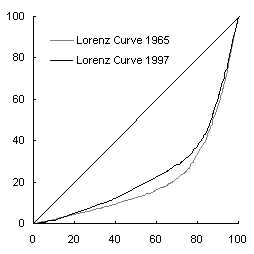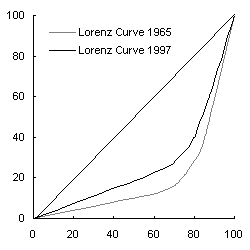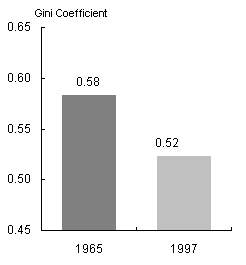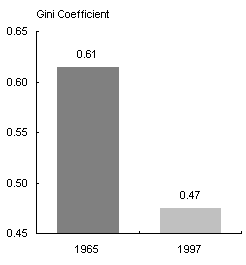The Annual Monash APEC Lecture
Tuesday 19 March 2002
By Dr Ken Henry
Secretary to the Treasury
Thank you for the invitation to speak to you tonight about the work that the APEC Finance Ministers are undertaking to restore growth in the East Asian region. My remarks will focus on Finance Ministers' work on promoting strong institutions, and robust regulatory arrangements and policies, to underpin financial markets. But I want to say something also about the response of Finance Ministers to the anti-globalisation movement. The way in which APEC Finance Ministers are responding to both of these challenges will have long lasting effects on the pace and pattern of regional economic growth.
APEC is a unique forum, having linked, for the first time, East Asia, North America, and Oceania in a framework that emphasises shared interests. It is important to Australia's goal of promoting regional engagement, providing an opportunity for regular meetings at the highest level with key regional counterparts.
The Asian Financial Crisis of 1997-98 highlighted the importance of strong institutions underpinning freer markets. While the economic downturn was relatively short-lived, it exposed weaknesses in prudential regulation, insolvency regimes and corporate governance that can only be overcome with many years work to train skilled regulators, accountants and lawyers and through initiatives designed to systemically integrate these enhanced skills into all areas of business activity.
As I will set out in more detail later, APEC Finance Ministers are addressing the need for long term strengthening of the institutions underpinning financial markets through training programs and policy dialogues among officials and ministers. This work is inevitably slow, unglamorous, 'behind the scenes', and low profile. It involves slowly building the capacity of cadres of officials, administrators and prudential supervisors. But, slow as it is, its success is vital to sound regional markets.
Beyond placing the spotlight on the need for long term development of financial markets, the Asian crisis also raised concerns about the desirability of trade- and investment-oriented growth. Few Asian policy makers, if offered the choice, would have accepted avoiding the recent crisis at the cost of missing out on more than three decades of rapid growth based on trade and investment liberalisation. Yet we are, nevertheless, faced with a vocal anti-globalisation movement that opposes free trade and liberal capital markets and links rapid economic growth based on international economic integration with economic volatility and high, and ever growing, income inequality and poverty.
APEC Finance Ministers have been working to participate positively in the globalisation debate, noting at their meeting in Suzhou, China, last year that the debate must be based on rigorous analysis; not cheap assertion.
One cheap assertion that has recently been tested is the claim that globalisation is making the rich people of the world richer and the world's poor poorer. Yet APEC Finance Ministers have noted that making the most of globalisation provides the surest means of restoring growth and ensuring rising and more equitable living standards in the East Asian region.
Before looking further at these two issues - APEC Finance Ministers' work on development of financial markets and their response to the anti-globalisation protesters - I will provide a brief overview of economic conditions in Asia.
The East Asian miracle in the decades prior to 1997 saw most nations in the region enjoying high saving and investment rates, robust growth, and moderate inflation in an environment of fiscal restraint and monetary stability. The Asian crisis inflicted major economic set backs on a number of economies in Asia, and ignited an intense regional debate on the role of international capital flows, financial market players, and the need for reform of domestic and international institutions.
One of the striking experiences of the Asian crisis was that its impact on unemployment and poverty was much smaller and less persistent than originally expected. In most economies, labour markets were flexible - in large part because they had to be in a region with relatively under-developed social safety nets. Part of the shock of the crisis was absorbed into wage reductions, rather than in soaring unemployment.
Rapid wage adjustment and the avoidance of large-scale unemployment assisted economic recovery in most affected economies, especially those that had either made vigorous early attacks on structural problems (such as Korea), or not had such severe structural problems (such as Thailand). Among the crisis-affected economies, by 1999 only Indonesia, with its special political and institutional challenges, had not returned to pre-crisis levels of GDP.
Significantly contributing to the region's rapid recovery from the downturn was the strong export-orientation of East Asian economies. Domestic demand growth made a relatively small contribution, notwithstanding accommodative fiscal and monetary conditions. This strong export-orientation has, more recently, exposed vulnerability to the current slowdown in the United States and Japan. But in the immediate aftermath of the Asian financial crisis East Asian exports recovered strongly, on the back of buoyant United States' demand for electronic goods, assisted, in most cases, by substantial exchange rate adjustments.
Yet, despite the strong post-crisis macroeconomic recovery, the Asian crisis had exposed some core structural weaknesses in some economies in the region - weaknesses that left them vulnerable to further shocks; vulnerabilities illustrated by the post-crisis paucity of foreign investment flows.
By mid 2000, conditions again started to decline. Slower growth in the United States, and the bursting of the `tech bubble' saw external demand weaken. Adverse external developments once again focussed attention on domestic problems - weak domestic demand in some economies, political instability, and the failure of some countries to adequately progress corporate and financial sector reform initiatives.
By the middle of 2001 a broad-based slowdown was in evidence across East Asia. Several countries moved into recession. The slowdown has been particularly pronounced in the newly industrialised Asian economies - Hong Kong, Korea, Singapore and Taiwan - and in South East Asian economies that have strong ties to the United States through the Information Communication Technology (ICT) production chain.
The recent downturn has not been as deep as during the Asian financial crisis. In 1997 the East Asian economies (excluding Japan and China) contracted by around 6 per cent; last year, growth is expected to have been around 1¼ per cent. The current period of weakness, however, is expected to be more protracted, so the eventual impact on the level of output is likely to be much closer than these comparisons suggest. The outlook for Japan has also deteriorated and market forecasts suggest that the economy will fare even worse this year than the 1 per cent contraction recorded in 1998.
The terrorist attacks of 11 September last year exacerbated the downward momentum already evident in the global economy. Much of the APEC region is likely to be adversely affected, directly or indirectly, by the resulting deterioration in the economic outlook and the side effects of the war to combat terrorism. Insurance and transport costs have risen, and optimistic estimates of productivity gains from 'just-in time' inventory systems are being revisited. Combating the financing of terrorism will unavoidably raise the finance sector's costs. In a sense, the events of 11 September can be considered an exogeneously imposed increase in the barriers to trade in goods and services, and especially to the free flow of
international finance.
But while the events of 11 September will unavoidably impact the regional economy, it is likely that growth will start to strengthen by mid year in line with broad-based global recovery. Already there are tentative signs that the United States economy has bottomed, or is close to bottoming. There are also early signs that the ICT cycle is starting to turn up. If this is the case, we should see a solid and relatively quick macroeconomic recovery in East Asia later in the year.
There are, however, important differences between this episode and the Asian crisis. The 1997-98 crisis was brought on by a financial shock. A sharp fall in confidence saw a dramatic turnaround in capital flows and pronounced financial market instability. The financial upheaval exposed financial and corporate sector weaknesses, which exacerbated the negative impact on the real economy.
In contrast, the current slowdown has been caused by a shock to the real economy - a downturn in the United States and weak global demand. Moreover, by historical standards the current global slowdown has been relatively mild: the slowdown in the United States is likely to be more moderate than in the early 1980s and early 1990s. On the other hand, relative to earlier periods of global weakness, regional impacts have been exacerbated by increasingly significant trade linkages between the United States and East Asia, and within East Asia, through the ICT production chain.
Over the past decade the structure of East Asian exports has changed dramatically, with electronics comprising a major part of exports. In Singapore, the Philippines and Malaysia, for example, electronics account for more than half of total exports. Two thirds of electronic exports are concentrated in electronic components and parts. This pattern of trade specialisation, and the sensitivity of prices and volumes of these products to shifts in global demand, tends to exacerbate the regional impact of swings in global economic activity.
Chart 1: Electronics contribution to exports - 2000
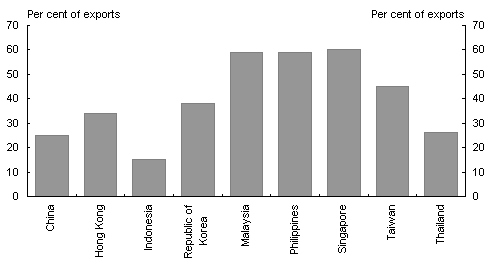
Source: CEIC Database.
The current downturn has not exposed new financial vulnerabilities. In part this is due to the nature of the shock. In large measure too, the response of international investors to the earlier crisis has reduced exposures to risk. But it also reflects the progress East Asian countries have made in recent years in strengthening their economies. Reflecting a combination of these factors, current accounts are generally now in surplus. The composition of muted capital inflows has shifted towards more stable FDI flows, and away from the more flighty bank-intermediated short-term lending. External debt levels have been reduced and reserves are generally comfortable. Exchange rates are more flexible. Substantial progress has been made on corporate and financial sector restructuring, and on governance. Positive developments in these areas have also provided more scope for macroeconomic policy settings to moderate the effects of adverse shocks.
Chart 2: Regional current account positions - 2001
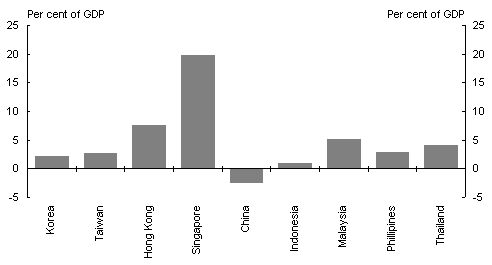
Source: IMF World Economic Outlook (WEO) October and December 2001 issues.
Notwithstanding this good progress, however, there are risks to the outlook.
The near-term risk is that the global economy may be slower to recover than currently expected. A slower recovery in the United States, and/or a further deterioration in conditions in Japan, could see East Asia suffer a deeper and more prolonged downturn. The region remains exposed to adverse shifts in sentiment.
A delayed recovery in ICT investment would also slow recovery. Recent industry forecasts suggest growth in ICT production will be weak in 2002, following the sharp falls in 2001. Growth is not forecast to strengthen significantly until 2003.
These are short-term risks. And they are not dominant. More important are the risks to a sustained pick up to the strong growth rates that preceded the financial crisis of 1997-98.
I would identify two such risks.
The first concerns the emerging pattern of trade specialisation to which I have just referred. Production and exports are increasingly heavily concentrated in a narrow range of product groups, particularly ICT. The ICT cycle is somewhat of a rollercoaster - last year, sales of semiconductors fell by over 30 per cent; after a slow year in 2002, sales are forecast to rise by over 20 per cent in 2003 and the same again in 2004. Demand volatility obviously comes at some cost.
Chart 3: World sales of semiconductors
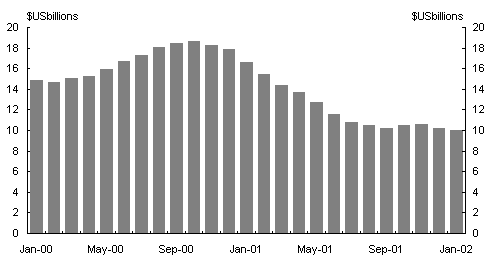
Source: Semiconductor Industry Association.
At the same time, prices of ICT products have tended to decline sharply - averaging 17 per cent a year in the last decade. Semiconductors are the new economy commodity export.
Chart 4: ICT Prices
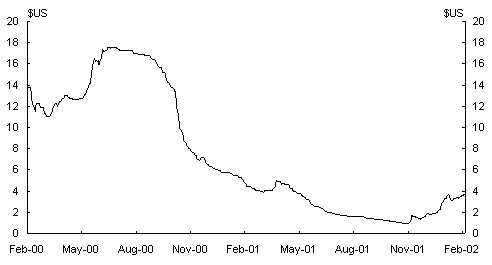
Source: Bloomberg.
Our own history illustrates as well as any the challenges for economic management posed by exports being concentrated in relatively low value-added, low margin, products subject to volatile demand and a trend decline in world prices. Yet, in respect of the terms of trade, the last ten years or so have been relatively kind to Australia. It is interesting to compare our experience with that of Singapore.
Chart 5: Australia and Singapore
Terms of Trade (Goods)
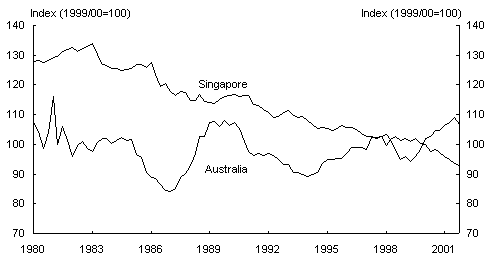
Source: ABS Time Series Statistics Plus Database; CEIC Database.
The second risk to sustained regional growth concerns the magnitude and direction of capital flows.
It is clear from the recent episode that East Asia is still heavily dependent on export-led growth. To sustain growth at a relatively high pace, and to moderate the effects of adverse global shocks, domestic demand needs to play a greater role. But this trite observation obscures a more basic truth. The sizeable current account surpluses being experienced by many East Asian economies are, by definition, matched by equally sizeable capital account deficits. That is, in terms of investment flows, broadly defined, more is flowing out than is flowing in. East Asia is exporting capital.
Chart 6: Developing Asia Crisis Countries
net private capital flows
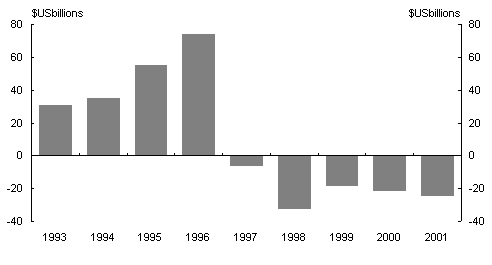
Source: IMF WEO December 2001 issue.
In contrast, the United States is the world's dominant capital importer. Global capital flows are favouring the most developed country on Earth, when one would have hoped that the better investment opportunities would be found in the developing world.
This should be of concern to anybody with an interest in regional economic development.
The pattern of investment flows reflects, overwhelmingly, investor perceptions of likely returns. Particularly since the events of 1997-98, in the calculations that international investors make the question of institutional risk - including regulatory and judicial systems and economic governance more generally - looms large. It is, indeed, likely that there was an insufficient appreciation of these risks in the pre-crisis period. Not so now.
One
set of such risks concerns the stability and integrity of the financial and corporate systems. While a lot of progress has been made here my sense is that there are some unresolved issues to confront. High levels of non-performing loans appear to remain a problem in several countries in the region. Corporate sector restructuring also seems to have some way to go. If companies are hamstrung by poor cash flows and high leverage, investment may not be forthcoming, even as the financial sector returns to better health.
APEC members' success in increasing the pace of their structural reforms will be an important determinant of the pace and sustainability of the regional rebound from the current global slowdown.
Even more important will be maintaining support for an open, outward looking trade environment, fundamental to which is a need to tackle recent criticism of globalisation - a topic to which I will now turn.
Finance Ministers' meetings have proven to be an effective forum in which to address the `globalisation' debate. At the APEC Finance Ministers' Meeting in China on 8-9 September last year, on the eve of the terrible events that were to hit New York and Washington, the Australian Treasurer led a discussion on promoting economic growth on a fair and equitable basis in a globalising world. He emphasised the importance of ensuring that the current debate about globalisation is based on a rigorous analysis of its impact, encouraging his colleagues to accept the overwhelming evidence that open economies are a powerful force for growth and poverty alleviation.
The APEC membership offers a microcosm of the wider world's experience with the post World War Two return to closer international economic integration. While this economic integration through trade and investment flows is only part of the multifaceted phenomenon that is globalisation, it is an important part of the phenomenon, and I will restrict my comment tonight to these economic dimensions.
In APEC communities, as in the broader world, it is frequently claimed that globalisation might well be making the rich richer, but it is making the poor poorer, widening the income distribution both within countries and between rich and poor countries. But as two World Bank researchers have concluded in a recent summary of the evidence,
'The problem with this new conventional wisdom is that the best evidence available shows the exact opposite to be true. So far, the current wave of globalization, which started around 1980, has actually promoted economic equality and reduced poverty.'1
The World Bank drew together this evidence in its December 2001 Policy Research Report, Globalization, Growth and Poverty: Building an Inclusive World Economy. In it, the Bank notes the unusual nature of the current wave of globalisation, which it dates from about 1980. Two earlier surges of globalisation, in the 19th century until 1914, and from the end of World War II until about 1980, did not produce any general catch-up by developing countries on the living standards in the industrial economies of the OECD, although there was catch-up within the OECD. There is little doubt that the inter-country distribution of income widened steadily from the dawn of the first industrial revolution until about 1975.
Researchers have suggested that the widening in inter-country inequality from World War II until about twenty or thirty years ago probably owed mostly to the unwillingness of most developing countries, in those earlier days when protectionist or state-planned development policies were fashionable, to lower their trade barriers as the OECD economies were doing through successive GATT rounds and in their regional and unilateral actions.2
It is notable, however, that even in the earlier period of 20th century globalisation from 1945 to 1975, when most of the limited 'catch up' on the living standards of the leading economies was occurring only among the OECD economies, there were already some developing APEC members such as Hong Kong, Korea, Singapore and Taiwan that began to grow strongly as a consequence of implementing more outward looking policies.
Since about 1975, increasing numbers of APEC economies have figured prominently among the 24 countries the World Bank has identified as 'recent globalisers' who have benefited strongly from the rapid expansion of global trade, and especially from growth in trade of manufactures. The World Bank concluded that these 24 recently-globalising developing countries, home to some 3 billion people, have benefited strongly from increasing their integration into the global economy since about 1980. However, some 2 billion people in other poor countries have not yet been able to achieve comparable increases in trade and investment linkages, and indeed their per capita incomes actually contracted during the 1990s.
The World Bank has concluded that recent progress has meant that, 'the long trend of rising global inequality and rising numbers of people in absolute poverty has been halted and even reversed'. Within APEC, China, Taiwan, Indonesia, Thailand and South Korea are among the world's best examples of how globalization and outward-looking domestic policies harnessing international trade and investment can rapidly lift hundreds of millions out of poverty.
We can see these effects at work in striking figures on the rate at which income gaps among APEC members have narrowed recently as they have built closer trade and investment links, both with each other and the broader world.
The following charts compare global data from 1965 and 1997 for 114 countries, showing first the whole grouping, and then the subgroup of APEC members for which we have data. The data are in the form of Lorenz curves of inter-country income inequality. These curves compare per capita GDP, converted at purchasing power parities, and they weight those per capita GDP figures by the population sizes of the respective economies. They thus provide a rough indicator of how command over goods and services has become more or less equal for the population of APEC.3
Chart 7: Lorenz curves of Inter-Country
Income Inequality
|
Lorenz curves: 114 countries |
APEC Lorenz curves |
|
|
|
Source: Melchior, Telle and Wiig (2000), Globalisation and Inequality: World Income Distribution and Living Standards, 1960-1998.
We can see that both for the 'world' of 114 countries and for the APEC group, the Lorenz curve moved inwards from 1965 to 1997: inter-country income distribution became more equal.
If we summarise the curve in a Gini coefficient, we see that inequality among the APEC members started higher in 1965 than in the broader grouping, but as trade barriers came down and economic reforms took root in countries such as China, Indonesia, Malaysia and Thailand, they began to catch up on richer APEC members and income inequality fell faster, and further, than in the world at large.
Chart 8: Gini coefficient:
114 countries and APEC
|
Global inequality fell |
APEC inequality fell more |
|
|
|
Source: Melchior, Telle and Wiig (2000), Globalisation and Inequality: World Income Distribution and Living Standards, 1960-1998.
These observations provide powerful testimony to the benefits of globalising policies.
So far, I have spoken only of inter-country inequality, based on a comparison of the average per capita GDPs of respective economies. A second question is, what has been happening to income inequality within each APEC member? Here again, APEC's experience is a microcosm of the broader world's.
Inequality has indeed gone up in some countries (such as China) and down in others (such as the Philippines). In yet others, such as Vietnam, it appears not to have changed, despite enormous economic transformations as the role of central planning has declined and the economy has been opened to foreign trade and investment.
This diversity of experience reminds us that economic globalisation is only one influence among many on domestic income distribution. Other important influences include education, training and health spending, and redistributive taxation and social spending patterns. Even the direction of the impact of globalisation on within country income distribution is indeterminate, as it depends on the country's starting point, and the nature of its intensification of international economic links. For example, was the original income distribution very compressed because of wage regulation and the absence of property income, as in China? Have growing trade links been through agriculture or simple manufacturing exports, so that many of the benefits go directly to low skilled workers, as in Vietnam?
The complexity of these linkages should caution us to accept that we cannot hope to produce pro-poor growth or to reduce national or inter-national inequality by somehow collectively regulating the economic processes of globalisation. Rather, it is principally for each country to adopt those national policies that will best maximise the gains for their poor.
The Asian crisis challenged many APEC economies to re-examine their policies for poverty alleviation - the crisis having borne out the common perception that crises have a significant adverse impact on poverty. They do this in various ways, some obvious, some less so.
In general, the entire income distribution is moved downwards in the aftermath of an economic crisis. That adjustment occurs because economic activity is lower, prices are generally higher, the relative price of tradeables rises, asset prices often fall, and fiscal policy often has to be tightened. Moreover, the 'depth of poverty' usually increases: depending a little on local circumstances and the degree to which people may be clustered near the poverty line, however measured, many may be pressed well below the poverty line for a period.
Crises generally also have idiosyncratic impacts on the exact profile of the national income distribution, depending on local circumstances. Perhaps surprisingly, the biggest losers in percentage terms in a crisis are not necessarily the poorest quintile, who in developing countries may be relatively insulated from market downturns by their limited involvement in the market economy. Frequently, in a crisis the largest percentage fall in income occurs in the second-poorest quintile. But in most cases the overall inequality of the income distribution, as measured by summary indicators such as the Gini coefficient, usually widens.
These impacts were sufficiently marked in the Asian crisis to show up in global poverty counts. While the proportion of the world's population in extreme poverty continued to fall notwithstanding the Asian crisis, the World Bank's researchers estimate that the recent fall in the absolute numbers of those below the US$1 a day benchmark was temporarily halted in the late 1990s as a result of the Asian crisis.4
Hardly any of this is news, but it does serve to remind us that crises are not only a terrible destruction of wealth, but are distressingly burdensome on the poorest members of society. That truism only reinforces the policy message that in confronting crises an ounce of prevention is worth a pound of cure, and that APEC must help its members redouble their efforts to build sound economic institutions, to develop and implement sustainable economic policies, and to undertake the structural reforms necessary to build their resilience against the next, unpredictable shock.
The Asian crisis indicates that openness to the global economy, and integration with it, while necessary for real human progress, is not itself sufficient to guarantee that progress will be secure and stable. Security and stability requires better domestic policies and institutions, better lending and investment assessments - including by the private sector in the industrial economies - and better performance from the international institutions.
There is a long and complex task of structural reform still to be completed in Asia - and not just in the crisis economies themselves. The institutional strengths required for good prudential supervision and transparent, sustainable economic policies are still being built and financial sector and corporate restructuring still have a way to go.
APEC Finance Ministers are contributing substantially to this task.
The APEC Finance Ministers' process, in operation for seven years, parallels the Senior Officials Meeting, or SOM as it is more commonly known. SOM is responsible for coordinating activities in a vast array of committees and working groups focusing, among others, on trade and investment, tourism, telecommunications, industrial science and technology, energy, and fisheries. The Department of Foreign Affairs and Trade manages Australia's input to this forum.
Although not widely known, Finance Ministers are leading a carefully planned and important work program, and are lending substance to APEC at a time when progress on trade and investment liberalisation is proving more elusive.
Finance Ministers' Meetings provide an opportunity for discussion of economic developments affecting the region, as well as encouraging effective responses to challenges confronting members, and pursuing cooperative programs to promote financial sector development. In the aftermath of the 1997-98 Asian Financial Crisis, these meetings have proved to be particularly valuable for developing dialogue and considering issues related to microeconomic reform, as well as macroeconomic and financial market developments.
Finance Ministers have adopted a long-term strategy for the promotion of economic growth and the strengthening of financial markets in the region, and are leading a number of well-targeted capacity-building initiatives aimed at creating more robust and resilient national financial systems. The range of collaborative initiatives address international financial reform by improving banking supervision, encouraging further capital market liberalisation, formulating strategies to strengthen social safety nets, promoting privatisation, and developing measures to improve transparency and strengthen corporate governance.
These initiatives have proven effective in prioritising training needs in the region and ensuring the delivery of high-quality programs. The financial regulators training initiative is a leading example, aimed at strengthening financial systems and promoting financial stability in the region, by providing training on bank supervision to junior and mid-level financial sector supervisors. It is expected that this initiative will strengthen training programs of national financial regulatory agencies, develop model curricula to provide standardised training programs, and strengthen collaboration of regional and international training programs for financial regulators.
Australia is committe
d to, and actively involved in, the APEC Finance Ministers' process, leading the APEC Future Economic Leaders Think Tank and the Company Accounting and Financial Reporting Task Force, as well as initiatives aimed at managing regulatory change (MRC) in life insurance and pensions, and strengthening corporate governance in the region.
Australia will host the second Think Tank in Sydney next month following the strong endorsement that the concept received at the inaugural session held in Sydney in August last year. This is an experimental program, focusing on building relationships and networks among the future financial and economic leaders in APEC and assisting the development of creative solutions to regional economic and financial challenges.
The corporate governance initiative was launched by Finance Ministers at their 1998 meeting in Kananaskis, Canada. The first phase of this project involved the preparation of the report, Strengthening Corporate Governance in the APEC Region, which contained a comprehensive analysis of the key corporate governance issues for the region. Finance Ministers at their 1999 meeting in Langkawi, Malaysia, endorsed the report and its recommendations.
At their summit in Auckland in September 1999 APEC Leaders made a strong commitment to the reform of corporate governance in the region. In their statement, The Auckland Challenge, Leaders pledged to work to strengthen markets, including by '(p)roviding greater transparency and predictability in corporate and public sector governance'. They also tasked their Finance Ministers to take forward the corporate governance agenda, including by '(d)eveloping and applying agreed corporate governance principles'. Australia has been a significant contributor to this initiative and in 2002 has joined Mexico, Korea and the Philippines as co-leader.
Throughout the region, there is widespread interest in doing everything possible to prevent a recurrence of the financial crisis that proved so crippling in 1997-98. Improving corporate governance is not only one way to do that, it is also a way to improve the efficiency of the economies themselves. APEC members realize that reforming their financial systems and strengthening corporate governance should not be delayed. Investors, both domestic and foreign, will demand these changes before bringing back the capital on which the regions' continued economic development depends.
For their part, APEC Finance Ministers are meeting these challenges by promoting training programmes and policy dialogues to strengthen financial markets. At the same time, they have engaged in the debate on globalisation, emphasising how economies that have been open to trade and investment have made much better progress in reducing poverty.
APEC is perhaps best known for its commitment to achieving free trade and investment by 2020. This commitment is not ideologically driven. Rather, it is a pragmatic regional response to the imperatives of economic development - a potent response to the critics of globalisation. Trade and investment liberalisation is, however, only part of the story. Equally important, if somewhat less glamorous, are the continued efforts - notably, the efforts of APEC Finance Ministers - to rebuild financial systems, and to develop regulatory arrangements and policies that will underpin sustainable investment activity and sustainable economic growth in the region.
1 David Dollar and Aart Kraay, Spreading the Wealth, in Foreign Affairs, January/February 2002
2 Peter H Lindert and Jeffrey G Williamson, (2001), Does Globalization Make the World More Unequal?, NBER Working Paper No. W 8228, April 2001. Available at:
http://www.nber.org/papers/w8228. See also David Dollar and Aart Kraay, Spreading the Wealth, in Foreign Affairs, January/February 2002.
3 Because of the limited PPP data set available over long periods, Russia, Vietnam and Brunei cannot be included in this comparison.
4 Shaohoua Chen and Martin Ravallion, August 2000, How did the World's Poorest Fare in the 1990s?, World Bank Working Paper No 2409, available at:
